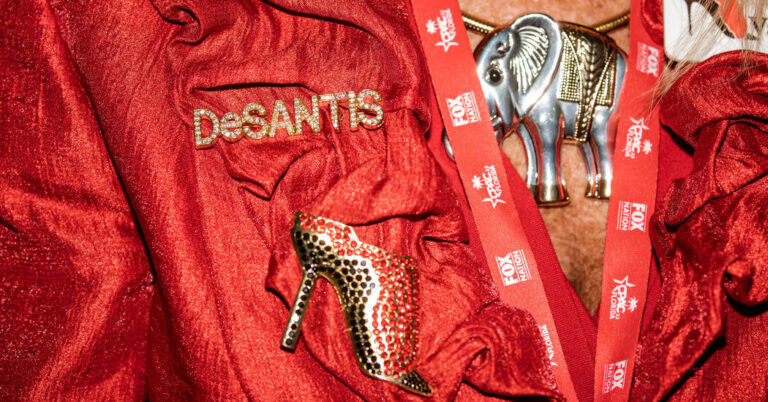Why the Watermelon Emoji Is a Symbol of Support for Palestinians
On and off social media, watermelons are being used as a symbol to communicate solidarity with Palestinians in the deadly war between Israel and Hamas.
The fruit is painted on semicircles of cardboard at protests in support of Palestinians. The watermelon emoji appears next to the Palestinian flag in display names on TikTok and X, and thousands of Instagram users have liked an illustration of a watermelon wedge whose seeds spell “ceasefire now.”
The fruit is grown in Gaza and the West Bank, and it is the same four colors — red, green, black and white — as the Palestinian flag. Palestinians have used it for decades as a symbol of identity and resistance, said Amani Al-Khatahtbeh, 30, the founder of the digital publication Muslim Girl.
“It’s taken on a much more widespread understanding” since the beginning of the war, Ms. Al-Khatahtbeh said. “There are people that have absolutely no connection whatsoever to Palestine and Israel, but they’re still using the emoji because of what it’s come to represent on social media.”
The watermelon emoji is among several symbols used as shorthand in the fierce social media debates about the war, but it is more subtle than the Israeli and Palestinian flag emojis and the hashtags #IStandWithIsrael and #FreePalestine — and that’s often intentional.
The watermelon symbol has roots in Israel’s suppression of the Palestinian flag in Gaza and the West Bank, said Sascha Crasnow, a scholar of Palestinian art and a lecturer of Islamic arts in the Residential College at the University of Michigan. The exact details of how the fruit became such a symbol are murky, she added.
In some versions of the story, watermelons were displayed instead of the Palestinian flag when it was effectively banned between 1967 and 1993, Dr. Crasnow said. A 1993 New York Times article that said Palestinians were once arrested for carrying watermelon slices was amended to note that the account could not be verified.
Another version connects watermelons to an exhibition by Sliman Mansour and two other Palestinian artists that was said to have been shut down by Israeli soldiers in the 1980s. Mr. Mansour, 76, wrote in a recent email to The New York Times that an Israeli soldier had told them not to paint anything in the colors of the flag, including watermelons.
“The officer wanted to express his disrespect for these colors — red, green, black and white — and what they represent,” Mr. Mansour said. He said he first painted a watermelon for a 1987 book of Palestinian folk stories.
The circulation of both stories established watermelons as a feature of Palestinian art, Dr. Crasnow said.
The artist Khaled Hourani, who created a watermelon flag design for the Subjective Atlas of Palestine in 2007, said he had seen his work and other watermelon images proliferate with each flare-up in the conflict.
“Art is part of this conflict,” said Mr. Hourani, 57, who lives in Ramallah in the West Bank. The war is not only a physical one, he added: “It’s about culture, it’s about representation.”
Symbols including the Star of David necklace and the kaffiyeh scarf have been embraced beyond the Middle East as a way of showing support for Jews and Palestinians during the war. The watermelon emoji has been popular among people supporting Palestinians while trying to evade what they argue is suppression of their speech on social media.
An emoji of a red and green watermelon wedge was introduced in 2015, and its use surged on social media during an escalation in the Israeli-Palestinian conflict in 2021, according to The Washington Post. The symbol now often appears alongside pro-Palestinian hashtags and in posts from organizations advocating a cease-fire, including Jewish Voice for Peace.
“The intention in using a watermelon is so that we don’t get censored,” said Ridikkuluz, 29, an Arab American artist who lives in Manhattan. Because social media platforms are unlikely to squash discussion of a common fruit, he said, the emoji can “subtly make its way through that crack in the door.”
In a blog post in October, Meta, which owns Facebook and Instagram, said it applied its content policies equally and that “there is no truth to the suggestion that we are deliberately suppressing voice.” A Human Rights Watch report released this month said Meta’s content moderation policies had resulted in “systemic censorship” of posts supporting Palestinians.
As the symbol’s profile has grown amid the Israel-Hamas war, watermelon imagery has also attracted scrutiny. Commenters on social media have responded to posts that include the symbol with Israeli flag emojis, calls to unfollow the posters’ accounts and accusations of antisemitism.
If the watermelon symbol’s potency once stemmed from the fact that it flew under the radar, Dr. Crasnow said, its meaning may have shifted as it has become more widespread.
“Instead of this subversive way of signaling to those in the know, it becomes a symbol to everyone else: We’re here,” she said. “It becomes this broader symbol of the scope of the individuals who are a part of this resistance.”
Check out our Latest News and Follow us at Facebook
Original Source







